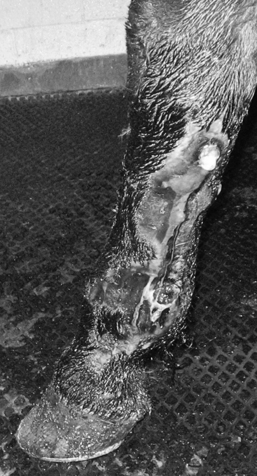CHAPTER 37 Methicillin-Resistant Staphylococci
Genus Staphylococcus consists of a variety of opportunistic pathogens of variable relevance in equine medicine. Staphylococci are grouped by their ability to produce the enzyme coagulase (Box 37-1), with coagulase-positive staphylococci being the most clinically important.
Box 37-1 Important Staphylococci and Their Coagulase Classification
| Coagulase Positive | Coagulase Negative |
|---|---|
| S. aureus | S. epidermidis |
| S. intermedius | S. sciuri |
| S. schleiferi coagulans | S. lentus |
| S. pseudintermedius | S. xylosus |
| S. delphini | S. haemolyticus |
| S. schleiferi schleiferi | |
| S. warneri |
METHICILLIN-RESISTANT STAPHYLOCOCCUS AUREUS
Epidemiology
Methicillin-resistant S. aureus infections can arise sporadically or in outbreaks on farms and in veterinary hospitals. All ages of horses can be infected, including foals as young as 24 hours of age. Age, breed, or sex predispositions have not been reported. Outbreaks appear to be more common on breeding farms, although objective evidence of increased risk is currently lacking. Few proper risk factor analyses have been reported for horses. Previous colonization of the horse, previous identification of colonized horses on the farm, antimicrobial administration within 30 days, admission to the neonatal intensive care unit, and admission to a service other than the surgical service are risk factors for community-associated colonization in horses admitted to a veterinary teaching hospital. Administration of cephalosporins or aminoglycosides during hospitalization is associated with MRSA acquisition in hospitalized horses.
Molecular Epidemiology
In humans a variety of “epidemic clones” account for most MRSA infections. In horses, the clone designated USA500 or Canadian epidemic MRSA-5 (CMRSA-5) appears to predominate (Figure 37-1). This is a human clone, but it is responsible for only a small percentage of human infections and appears to survive preferentially in horses compared with other MRSA clones. This clone, or closely related clones, has been found in horses in North America and various countries in Europe and is likely disseminated widely in the horse population. Infections can be caused by other strains but this is less common. Recently, sequence type 398 (ST398) MRSA has been identified in horses in Europe and Canada and may be an emerging problem.




